Introduction
.jpg)
Twenty-seven years ago when I had experienced very little psychic phenomena, I was intrigued and excited by an article in the Psychic News.
I wanted to know more.
A few weeks later a letter appeared in the Correspondence column, vilifying the inclusion of the Easter Message plate, as "everyone" knew Hope was a fraud and it had been "proved many times." I was puzzled. If this was so why would such a prestigious publication republish an event after 85 years if it was a fraud?
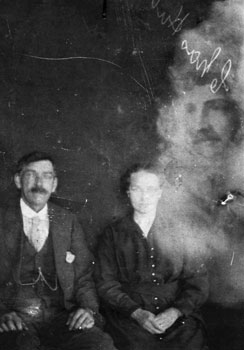
I had seen the photos of the Harrison, Besant and Hudson families with "spirit extras" taken by this photographer, and knew the history behind them; also those of the Cowell-Pughs and Battens – all well respected Middlesbrough Spiritualist families. Tom Harrison (later to be my husband) had told me how the plates would be developed in the bathroom, some even at the Hudson's house (later to be his in-laws) and held up to a gaslight to see if there was an "extra" on the glass plate before they were printed. How could they be fakes? Why would someone suggest they were?
Within a month, Tom, on one of his monthly visits to see a 90-year-old spiritualist in Sheffield, borrowed a book from him, bought 73 years before, which was to answer part of my question. It was Sir Arthur Conan Doyle's A Case for Spirit Photography, written in defence of the medium following a charge of fraud by Harry Price and the Society for Psychical Research (S.P.R.).
This was a door to another world. I devoured the words and began to understand how despite hundreds of people confirming the appearance on photographic plates of images of deceased loved ones just ONE person could cry 'FRAUD' and it was believed and accepted above all others. And 70+ years later some still believed it, despite the many positive responses from known and unknown sitters, researchers and experimenters.
As it approached 100 years from the original outcry, I decided to try to solve the puzzle. I was given the opportunity of delving into the archives of original publications at the Arthur Findlay College. I spent many hours searching others preserved in the IAPSOPsite on the 'net', as well finding detailed records in the books lining the shelves in my small study, to bring you "watertight" and moving accounts from the ten years following Price's "exposure" – as well as those from the years before William Hope was well known. It has not been an easy journey and I have to say there is more to the Price-Hope controversy than I first thought. Unravelling it has been a challenge – and there were others.

Was William Hope a true medium with a rare and particular gift — or a trickster as some believed? ...
At the close of the S.S.S.P. Conference that year (1920) this 'resolution' was adopted:
"The members of the Society for the Study of Supernormal Pictures present at this meeting, desire to place on record the fact that, after many tests and the examination of thousands of Pictures, they are unanimously of the opinion that results have been supernormally obtained on sensitive photographic plates, under reliable test conditions. At present the members do not undertake to explain how the results are obtained, but they assert that they have undoubtedly been secured under conditions excluding any possibility of fraud."
Stanley De Brath wrote in Psychic Science April 1933
"We have lost in him one of our very best mediums for supernormal photography, and a very simple-minded and sincere man.
He has comforted scores of bereaved souls with whom he was entirely unacquainted, by portraits of their lost relatives, plainly recognisable from photographs taken in life. He has been vehemently attacked both in England and on the Continent, ignoring the fact that an immense repertory of normal portraits and an extraordinary versatility in extracting information, would have been necessary to support the charge of fraud."
Rev. Charles Tweedale wrote in 1940
The Chief-Constable and his wife
Some years ago there was a ring at my front door-bell at 7 a.m., and the Chief Constable of Sunderland (This should be Newcastle). was announced. On going down to the dining room into which he had been shown, I found that he was accompanied by one of his daughters, and he came to make enquiries about Mr Hope, and proposed motoring on to Crewe and having a sitting with him. He had breakfast with me, and about 8.30 set out in his car for Crewe.
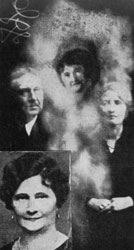 Afterwards, he informed me that he arrived about noon, and at once had a sitting with Hope who was not aware of his coming. The Chief Constable had lost his wife only about ten days previously, she having died of cancer. To his great delight he obtained at this sitting a marvellous spirit photograph of his deceased wife. It was so wonderfully accurate and such a good likeness that he was greatly impressed, but there was apparently one little discrepancy – “one little fly in the ointment”, so to speak. That made him hesitate, although the likeness was so perfect; the hair in the spirit photograph was parted on the right side, whereas his wife invariably parted her hair on the left. Afterwards, he informed me that he arrived about noon, and at once had a sitting with Hope who was not aware of his coming. The Chief Constable had lost his wife only about ten days previously, she having died of cancer. To his great delight he obtained at this sitting a marvellous spirit photograph of his deceased wife. It was so wonderfully accurate and such a good likeness that he was greatly impressed, but there was apparently one little discrepancy – “one little fly in the ointment”, so to speak. That made him hesitate, although the likeness was so perfect; the hair in the spirit photograph was parted on the right side, whereas his wife invariably parted her hair on the left.
As soon as he got a print from the negative he hurried to the nurse, who had nursed his wife through her terrible illness, and said to her, “Nurse, did you ever see my wife with her hair parted on the right? “The nurse at once replied, “Oh yes, sir, didn't you know? I parted her hair on the right for ten days before she died in order to ease her head on the pillow.”
That settled it, and was one of the most evidential details that could be imagined, and one that completely destroys the theory of telepathy and the subconscious. On the back of the photograph from which Plate XXV is made, he has written : “This is a perfect likeness of my wife.– F. J. C.” It is certainly one of the most evidential spirit photographs ever taken and the most casual inspection shows the difference in the arrangement of the hair, and in other details.
Sir Arthur Conan Doyle wrote in 1922
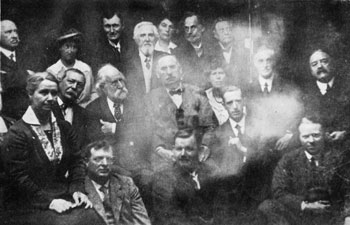 "At the annual meeting of the Society for the Study of Supernormal Pictures, I being present, a photograph of the members was taken in the normal way as a souvenir. As Hope was present, it was suggested that a second photograph be taken by him in the hope that we might get some psychic effect. The plate was taken from an unopened packet in the pocket of the secretary, and some fifteen of us were witnesses of the whole transaction. Hope had no warning at all and could have made no preparation. The plate was at once developed by one of our own members, and a well-marked extra, amid a cloud of ectoplasm, appeared upon the picture. This extra was claimed by one of our members as a good likeness of his dead father. This result, which is illustrated [above] was obtained before an audience of experts—if any men in this world have a right to call themselves experts upon this subject. How can it be explained by fraud and how can such a case be lightly set aside? Granting for argument’s sake that the sitter may have been mistaken in the recognition, how can the actual psychic effect be accounted for?" "At the annual meeting of the Society for the Study of Supernormal Pictures, I being present, a photograph of the members was taken in the normal way as a souvenir. As Hope was present, it was suggested that a second photograph be taken by him in the hope that we might get some psychic effect. The plate was taken from an unopened packet in the pocket of the secretary, and some fifteen of us were witnesses of the whole transaction. Hope had no warning at all and could have made no preparation. The plate was at once developed by one of our own members, and a well-marked extra, amid a cloud of ectoplasm, appeared upon the picture. This extra was claimed by one of our members as a good likeness of his dead father. This result, which is illustrated [above] was obtained before an audience of experts—if any men in this world have a right to call themselves experts upon this subject. How can it be explained by fraud and how can such a case be lightly set aside? Granting for argument’s sake that the sitter may have been mistaken in the recognition, how can the actual psychic effect be accounted for?"
The Editor of Light Mr David Gow had followed up the account and published this confirmatory piece.
"The foregoing was substantiated afterwards in a communication sent to me by Mr. Barlow on a slide for lectures. On learning that the psychic face partly shown in the centre of the photograph, was recognised by Mr. Jeffrey as that of his father, long deceased, I called upon him (at his residence, 15, India-street, Charing Cross. Glasgow on Friday, November 19th, 1920) and asked about this psychic picture. He stated that he was fully convinced that it was an excellent likeness of his father, and showed me two photographs, one of his father in life and the other of a nephew. On examining these and comparing them with the psychic production. I was impressed with the physiognomic resemblance which seems to justify Mr Jeffrey's conviction.
In conclusion, it must be remembered that, apart from the scientific value of the photograph which holds good whether the recognition is undoubted or not – neither of the psychics, Mr. Wm. Hope and Mrs. Buxton could have met the original in the body, nor have seen his photograph, which is not identical with the psychic picture.
[In the Spring of 1922] a business man who had been Chairman of a large company in Britain, and also, for a while, a J.P. of an important district in the North of England, applied for a sitting with the Crewe Circle at the College of Psychic Science. At this time, he was not a member of the college, and knew very little of the subject, except from reading. He was a complete stranger to the Crewe Circle. “His desire was to test “truth” for himself, and he gave the very best conditions for mediumistic experiment while closely watching the whole photographic process.” (Psychic Science July 1923)
He supplied his own plates, having marked them carefully, and expressed himself as perfectly satisfied with the procedure. When the prints were sent to him, he did not recognize the “extra”, but it made a profound impression on him, and there remained a feeling that identification would come in time.
Almost a year later he wrote to the college telling them of success in identifying the “extra”.
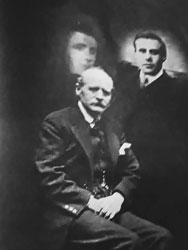 "I happened to show the photograph to one of our old domestics, telling her she might take it to the servants’ hall should the rest of the staff care to see it. Imagine my surprise on her telling me the next day that our housekeeper-cook, Mrs. M—, had at once recognized the face as being that of her late husband but when a younger man, and as she first knew him. M— was my butler, and while in my service joined up and lost his life. My housekeeper fetched from her room a small photo of her husband at a younger period of his life than I had known him, and I saw in it the expected identification which, for the last ten months, had been in my mind. Two others of my old domestics were struck with the resemblance to M— as they had first known him. I forwarded the small photo to the College to be examined." (See inset in this photograph) "I happened to show the photograph to one of our old domestics, telling her she might take it to the servants’ hall should the rest of the staff care to see it. Imagine my surprise on her telling me the next day that our housekeeper-cook, Mrs. M—, had at once recognized the face as being that of her late husband but when a younger man, and as she first knew him. M— was my butler, and while in my service joined up and lost his life. My housekeeper fetched from her room a small photo of her husband at a younger period of his life than I had known him, and I saw in it the expected identification which, for the last ten months, had been in my mind. Two others of my old domestics were struck with the resemblance to M— as they had first known him. I forwarded the small photo to the College to be examined." (See inset in this photograph)
He goes on: "There is one striking resemblance between the life and spirit photographs which I think must have impressed me, namely the expression of innate goodness which was so typical of the man himself. Neither his widow nor I would have any objection to your making public use of this letter, and I would like to take this opportunity of expressing my gratification to the College for the consolation I have received through membership, giving me assurance of spiritual existence after death."
Mrs. McKenzie comments: "It has been frequently known that the "extras" reveal the communicating spirit as younger than when death occurred. Perhaps our spirits are hampered by the flesh after middle life and, having thrown this off, take on an unexpected youthfulness. The negative and letters are in the possession of the College."
Tributes
Ernest Oaten – Editor of The Two Worlds – March 17th 1933
For over twenty-five years Mr. Hope and Mrs. Buxton have been the centre of the Crewe Circle, and over a long period Archdeacon Colley and Mr. Wm. Walker supervised the circle and tabulated the results.
Gradually the fame of Mr. Hope spread, and it is safe to say that influential men and women from all over the world have visited Crewe. In the vast majority of cases they have gone away with the conviction that psychic photography was a fact, and that it is possible to get reproductions on photographic plates of people long since dead. Scores of professors from European Universities have visited him, while journalists, chemists, photographic experts, detectives and professional men of all types have visited Crewe. Of course, in the nature of the case, sceptics have occasionally levelled charges of fraud against Hope, but a serious survey of the whole of the facts, even of these charges, will convinced the unbiassed mind of the amazing lengths to which critics have to go even to establish a suspicion of fraud. In spite of recent attacks made upon Mr Hope’s mediumship, we do not hesitate to say that the evidence he has produced on hundreds of occasions is convincing to any fair-minded man.
The most repulsive and detestable practices have often been resorted to in order to lure him into a position which would compromise his reputation.
He has been known for many years as the most successful spirit photographer Spiritualism has produced. Now that he has passed on, he has left behind him a reputation even in the minds of hundreds of sceptics who have sat with him, which will stand unsullied amidst all the attacks.
Even if nothing else had emerged from Mr Hope's mediumship he has done more than any other medium of his type to enable us to determine what are the definite scientific conditions under which psychic photography should be obtained.
He was a lovable type of man but he took strong likes and dislikes. If you won his friendship and his confidence, you could practically conduct your experiment as you liked. He gave you a free hand. If he took a dislike to a sitter, he was adamant in his refusal to do anything to oblige that sitter.
His work will be criticised through the years yet to be, but there are thousands of people in this country who have learned to love and respect William Hope.
Rev. Charles Tweedale in “Vindication of William Hope” (1933)
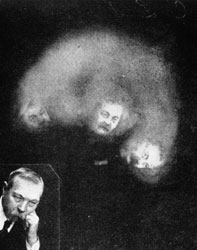 "I knew Hope intimately for 15 years, during the whole of which time I found him to be an upright, God-fearing, honourable and transparently honest man, and I count it an honour to have known him and to have received him into my house. He had God-given powers which rank him as the equivalent of one of the great prophets of old time, nay caused him to exceed them, in his powers of demonstrating the Spirit World, human survival, and ‘the life of the world to come." "I knew Hope intimately for 15 years, during the whole of which time I found him to be an upright, God-fearing, honourable and transparently honest man, and I count it an honour to have known him and to have received him into my house. He had God-given powers which rank him as the equivalent of one of the great prophets of old time, nay caused him to exceed them, in his powers of demonstrating the Spirit World, human survival, and ‘the life of the world to come."
(Rev Tweedale is covered by the central image of Conan Doyle.)
James Lewis, Editor of the International Psychic Gazette (1933)
"He was a simple-minded, honest, truthful, inoffensive, richly-gifted medium, whose powers had been tested and proved genuine by hundreds of critical and uncritical observers, from Sir William Crookes down to humble investigators wanting infallible proofs of the survival of their own dear ones, whose portraits they were not likely to mistake."
|